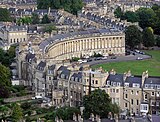
Bath and North East Somerset (commonly referred to as BANES or B&NES) is a unitary authority occupying an area of 220 square miles (570 km2), two-thirds of which is green belt. It stretches from the outskirts of Bristol, south into the Mendip Hills and east to the southern Cotswold Hills and Wiltshire border. It includes 663 Grade I listed buildings, one of the highest concentrations in the country, covered by about 100 English Heritage listings. The oldest sites within Bath are the Roman Baths, for which the foundation piles and an irregular stone chamber lined with lead were built during the Roman occupation of Britain, although the current building is from the 18th century. Bath Abbey was a Norman church built on earlier foundations, although the present building dates from the early 16th century. The medieval era is represented by the remains of the city walls in Upper Borough Walls.
Most of Bath's Grade I listed buildings are made from the local golden-coloured Bath Stone, and date from the 18th and 19th centuries. Their dominant architectural style is Georgian, which evolved from the Palladian revival style that became popular during the early 18th century. This led to the entire city's designation as a World Heritage Site. Much of the development, and many of the buildings, were the vision of John Wood, the Elder. The Circus is seen as the pinnacle of Wood's work. The best known of Bath's terraces is the Royal Crescent, designed by Wood's son, John Wood, the Younger. Around 1770 the neoclassical architect Robert Adam designed Pulteney Bridge, a three-arched bridge spanning the Avon. Outside the city of Bath most of the Grade I listed buildings are Norman- or medieval-era churches, many of which are included in the Somerset towers, a collection of distinctive, mostly spireless, Gothic church towers. Manor houses such as Claverton Manor, which now houses the American Museum in Britain, and the 18th-century Newton Park, which has a landscape garden designed by Capability Brown. (Full article...)